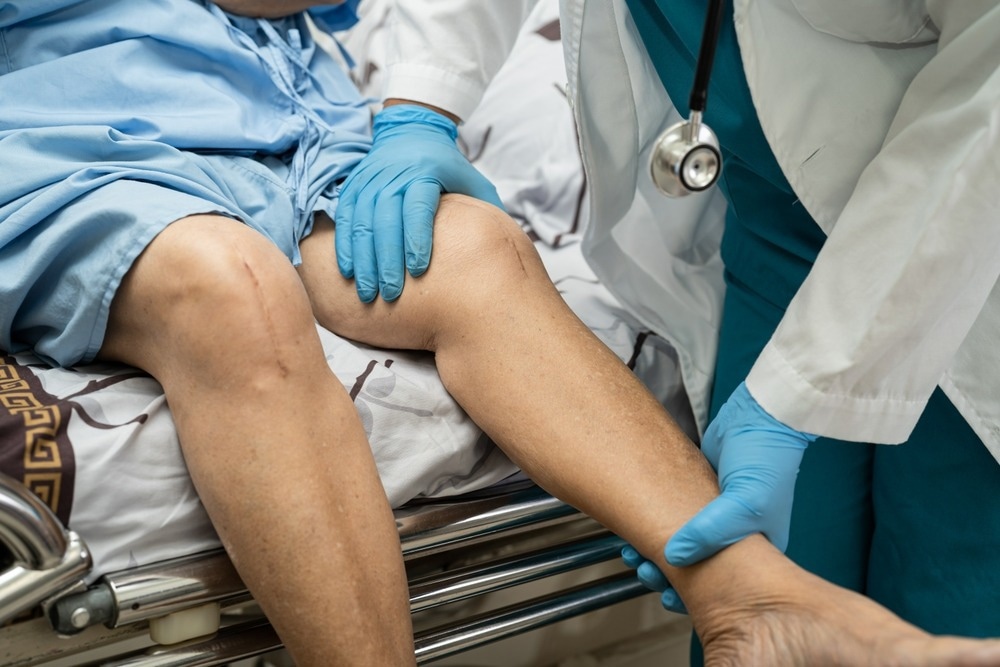Rheumasurgery: Improving Function and Relieving Pain

Rheumatoid arthritis (RA)
Synovectomies
Joint replacement
Arthrodesis
Allo-arthroplasty
References
Further reading
Rheumasurgery, also known as Rheumatoid Surgery, is concerned with the surgical treatment of patients suffering from rheumatic disorders and rheumatism. A Rheumasurgeon aims to improve patient function, limit disease progression, and relieve pain. Rheumasurgical interventions can include synovectomies, joint replacement, and repositioning of joints.

Image Credit: Chinnapong/Shutterstock.com
Rheumatoid arthritis (RA)
Rheumatoid arthritis (RA) is a chronic inflammatory autoimmune disease that causes significant systemic symptoms. Common manifestations include joint inflammation, cartilage destruction, and ligament weakness. Around 70% of rheumatoid patients suffer painful and severe hand problems. Gradual loss of hand function in RA patients impairs their ability to care for themselves and their productivity in society.
The first step towards treatment is an early evaluation by a hand surgeon familiar with RA to establish a treatment program that reduces the occurrence of uncorrectable late abnormalities.

Image Credit: NAR studio/Shutterstock.com
Hand surgery for RA is classified as either preventative or reconstructive. Synovectomy, joint synovectomy, and tendon rebalancing are all preventive operations. Arthrodesis, arthroplasty, and tendon transfer are examples of reconstructive procedures. The surgical treatment strategy is determined by the particular patient, the joints involved, and the intended outcome.
To minimize unrealistic post-surgical expectations, the surgeon must clarify the limitations and hazards of surgery with the patient, regardless of the operational method. Normal function is never restored with RA hand surgery.
The wrist is the most often implicated upper extremity region in RA, with around 75% of RA patients experiencing wrist symptoms. Wrist RA can be treated conservatively or surgically with procedures such as synovectomy, wrist arthrodesis, and arthroplasty.
Synovectomies
A synovectomy is recommended if pain, edema, and radiological abnormalities do not disappear after 3-6 months of adequate therapy. Together with ankle joint tendons, the wrist, and its extensor tendons are frequently affected. In the early stages, treatment with radiosynoviorthesis or arthroscopic synovectomy is indicated if there is no cartilage injury. Early synovectomy can minimize discomfort and swelling while also limiting movement. However, the course of intraarticular cartilage breakdown cannot be totally stopped but can be postponed.
Arthroscopy synovectomy was first used to treat knee joints in the early 1980s. The method and apparatus were further enhanced in the 1990s, increasing the usage of wrist arthroscopy. In RA patients with refractory wrist edema, arthroscopic synovectomy provided results comparable to conventional surgery and satisfactory results. This approach has various advantages over traditional surgical synovectomy. It has decreased postoperative morbidity, a shorter hospital stay, and early rehabilitation. An arthroscopic synovectomy is usually advised in early-stage RA, but it is not recommended for significant wrist joint degeneration.
Radiation synovectomy is a common nuclear medicine treatment for individuals with discomfort, recurring joint effusion, and restricted movement caused by inflammatory and degenerative joint disease. Radiation synovectomy is appropriate for individuals with clinical symptoms despite routine anti-rheumatoid medication therapy. A pre-therapeutic three-phase bone scan reveals clear indicators of hyperperfusion in their painful joints, indicating synovitis. The best outcomes are obtained in patients in the early stages of true RA.
Joint replacement
A joint-preserving operation is not viable if the inflammation has ruined the cartilage in the joint. In this instance, the joint must be replaced with alternative possibilities. This includes resection-arthroplasty, arthrodesis, or allo-arthroplasty, most typically performed at Larsen stages three or higher. All techniques strive for a pain-free joint with good load-bearing capability.

Image Credit: sasirin pamai/Shutterstock.com
Arthrodesis
Primary arthrodesis for rheumatic joint treatment results in a stable joint free of inflammation and pain. Depending on bone quality, stability, and surrounding joints, an arthrodesis or an arthroplasty may be the best option for the ankle joint.
The advantages of ankle arthroplasty versus arthrodesis are obvious and include a range of motion that allows for walking while putting less strain on the adjacent proximal and distal joints. The most prevalent bone operation in RA is wrist arthrodesis. Total wrist arthroplasty is indicated in patients with painful, pancarpal advanced RA who are ready to adopt a low-demand lifestyle but want to be able to undertake activities.
Allo-arthroplasty
Allo-arthroplasty has become the gold standard for most arthritic joints. The onset of rheumatoid arthritis is sooner than osteoarthritis, and it even has a role in juvenile arthritis. Knee arthroplasties can be cemented or hybrid (cement-free femur and cemented tibia). Higher experience and promising results justify allo-arthroplasty for other joints, such as the shoulder, ankle, wrist, and elbow.
Rheumatoid patient treatment is complicated. When planning reconstruction, always ask the patient about their needs. While patients may typically compensate for their deformity, the deformity is not a justification for reconstruction. Rheumatologists must also be included in the rebuilding conversation. These can be very useful in pre-and postoperative drug management for patients.
References
- Kozlow, J. H., & Chung, K. C. (2011). Current concepts in the surgical management of rheumatoid and osteoarthritic hands and wrists. Hand clinics, 27(1), 31–41. https://doi.org/10.1016/j.hcl.2010.09.003
- Chalmers PN, Sherman SL, Raphael BS, Su EP. Rheumatoid synovectomy: does the surgical approach matter?. Clin Orthop Relat Res. 2011;469(7):2062-2071. doi:10.1007/s11999-010-1744-3
- Trieb K, Hofstaetter SG. Treatment strategies in surgery for rheumatoid arthritis. Eur J Radiol. 2009;71(2):204-210. doi:10.1016/j.ejrad.2009.04.050
- Kim, S. J., & Jung, K. A. (2007). Arthroscopic synovectomy in rheumatoid arthritis of wrist. Clinical medicine & research, 5(4), 244–250. https://doi.org/10.3121/cmr.2007.768
- Rheumatology. [Online]. Aster Hospital. Available at: https://www.asterhospitals.ae/specialisations/detail/rheumatology
Further Reading
- All Pain Content
- Using a Pain Diary
- How Do We Sense Pain?
- Role of Dopamine in Pain
- Common Causes of Stomach Ache
More…
Last Updated: Apr 19, 2023
Source: Read Full Article